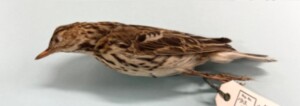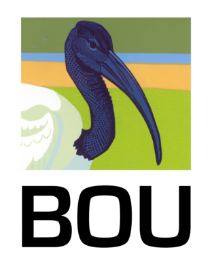Changes to the British List (12 Aug 2025)
The British Ornithologists’ Union Records Committee (BOURC) has made the following changes to the British List.
The following species has been moved from Category D to Category AE of the British List:
 Booted Eagle Hieraaetus pennatus (Gmelin, JF, 1788)
Booted Eagle Hieraaetus pennatus (Gmelin, JF, 1788)
One, second-calendar-year, pale morph, St Margaret’s at Cliffe, Kent, 28 September 1999; same Porthgwarra and Drift Reservoir, Cornwall, 26 October-6 November 1999 (probably since 23 October 1999) (photographed); same Marazion, Cornwall, 8-9 November 1999; same Tremethick Cross, Cornwall, 9-11 November 1999; same third-calendar-year, pale morph, Meare Heath and Shapwick Heath, Somerset, 6-9 February 2000 (probably since 2 February 2000) (photographed); same Chew Valley Lake, Avon, 11-15 February 2000 (photographed); same Dungeness, Kent, 7 April 2000; same Cliffe, Kent, 8 April 2000; same North Ronaldsay, Orkney, 22 June 2000.
Photo (right): Booted Eagle © James Eaton
Prior to its discovery in Kent on 28 September 1999 this Booted Eagle had been present in Ireland, in Wexford and roaming to Dublin and Waterford, between 7 February-5 April 1999 and again between 16 April and early July, visiting Northern Ireland, in Down on 9 April 1999, and in Antrim between 22-24 August 1999. Its occurrence has previously been considered by BOURC in conjunction with the Irish Rare Birds Committee (IRBC) and the Northern Ireland Birdwatchers’ Association Records Committee (now Northern Ireland Rare Birds Committee; NIRBC) in 2002 and whilst the identification was accepted, the species was placed in Category D due to uncertainties of its origin. At that time it was the view of the three committees that this Booted Eagle was not acceptable for admission to Category A on the basis of i) the bird’s abnormally abraded plumage; ii) the very early arrival date; iii) the long sea crossing implied by its arrival in Ireland; iv) the long stay within Ireland and Britain contrasting with the short stay of most vagrant raptors; v) the fact that, although rare, the species is not unknown in captivity (Ibis 145: 181, Br. Birds 95: 525; Ir. Birds 7: 108; Northern Ireland Bird Report 1999: 45; Irish Bird Report 2023 in press).
Since 2003 three further Booted Eagles have been documented in England: an at least second-calendar-year in Cornwall at St Just on 20 May 2024; a first-calendar year in Cornwall at Nanquidno on 10-11 October 2024 that was relocated at and around Marazion on 12 January-4 April 2025 before visiting Kent on 10-11 April, and Norfolk and Suffolk between 11 April and 25 May 2025; and a first-calendar-year in the Chilterns in Oxfordshire, Berkshire, and Buckinghamshire between 31 October-2 November 2024 that later visited Lundy, Devon on 29-30 April 2025. None of these individuals showed any indication of captive origin, unlike an at least third-calendar-year Booted Eagle that temporarily escaped from captivity in East Glamorgan in November 2008, adding the species to Category E (BBRC; Eastern Glamorgan Bird Report 2008).
Category D is a holding category and is not intended to be a long-term assignment and species are reviewed periodically with a view to assign them to either Category A or Category E and a review of Booted Eagle records has now been completed (Ibis 164: 863).
Revisiting the 1999-2000 Booted Eagle with the benefit of the experience of the records in Britain during 2024-2025 and a better understanding of vagrancy in raptors, the sea-crossing and long-stay is no longer a concern for BOURC. Two subsequent autumn first-calendar-years in Britain both apparently remained until the following spring. Like many large raptors, Booted Eagles avoid water crossings, and migrants may wait for several days even to cross narrow sea straits such as at Gibraltar (e.g. Bird Study 60: 409-413). However, in exceptional circumstances flocks of hundreds have arrived on the Balearic Islands (e.g. Migration Strategies of Birds of Prey in Western Palearctic pp. 101-107) where they have become at least temporarily apparently ‘trapped’ – reticent to leave for mainland Europe. Vagrants have seemingly also undertaken more substantial oceanic-crossings to reach Madeira and Iceland. Thus, although the species is behaviourally averse to sea-crossings, individuals are physiologically capable of undertaking them when conditions are conducive to such movements. This combination of factors may explain the long-stays by this and other large broad-winged raptors recorded in the British Isles which have moved extensively – potentially searching for an alternative land-bridge or shorter sea crossing to return to the Continent.
The less likely long sea crossing from mainland Europe to Ireland and apparent early spring arrival date can both be explained by the individual having arrived (unseen) in Britain in autumn 1998 before crossing to Ireland where it over-wintered (although a direct crossing to Ireland in autumn 1998 remains a possibility); a similar journey was made by an Egyptian Vulture Neophron percnopterus percnopterus in 2021-2022 which again demonstrated the potential for large birds of prey to remain in the UK and Ireland unrecorded by birders for months (Ir. Birds 45: 64; BOURC in press).
According to estimates derived from CITES wildlife trade data (Biol. Conserv. 284:110216), during the period 1975-2020 a total of 29,657 individual diurnal raptors (of 47 species) were exported from the UK (the largest exporter of live raptors) and 3308 (of 70 species) were imported. Among these totals of birds imported into the UK is an estimate of one Booted Eagle and one Short-toed Eagle Circaetus gallicus, versus, for example 20 Wahlberg’s Eagles Hieraaetus wahlbergi and 18 Ayres’s Hawk-Eagles H. ayresii. To better understand the status of captive Booted Eagles, BOURC organised a meeting with Adam Bloch and Holly Cale of the Horstmann Trust (a vulture conservation charity) who generously assisted the committee (along with invited representatives from IRBC and NIRBC) by advising both on the likelihood of the 1999-2000 Booted Eagle being an escape from captivity and in interpreting the state of the bird’s plumage. Adam and Holly confirmed that Booted Eagle has remained rare in captivity throughout the period, and the majority held are injured wild birds with few captive juveniles documented; just one was known to have hatched in Europe in 1999. The cause of the damage to the rectrices and remiges of this second-calendar-year Booted Eagle in late winter remains unexplained, but it is not necessarily an indication of previous confinement and may reflect ontogenetic issues, poor provisioning, local meteorological conditions or even damage resulting from interactions with other bird species. Thanks to the proliferation of bird images online in places like the Macaulay Library, BOURC were able to find images of birds in similar plumage states elsewhere in Europe in winter. Given all this new information, on review, BOURC members voted to place the record in Category A of the British List by a majority vote based on the 1999-2000 individual. The IRBC and NIRBC have also added the same Booted Eagle record to their respective national lists, and records of Booted Eagle in Britain in 2024-2025 will be published by the British Birds Rarities Committee.
Booted Eagle breeds in northwest Africa, southern Europe (as far north as central France) to central Asia and north India, also South Africa, and is migratory – wintering in Subsaharan Africa and the Indian Subcontinent, with a range and migration pattern similar to other raptors (Accipitridae) on the British List such as Egyptian Vulture and Short-toed Eagle (IOC World Bird List (v 15.1)).
Booted Eagle is monotypic and should be placed after Short-toed Eagle on the British List.
 Pechora Pipit Anthus gustavi gustavi (Swinhoe, R, 1863)
Pechora Pipit Anthus gustavi gustavi (Swinhoe, R, 1863)
New first record: one, first-calendar-year or older, male, 1 October 1913, Auskerry, Orkney, specimen at National Museums Scotland, Edinburgh (Accession number NMS Z.1913.238.3), pre-dates the previously accepted first record of this species and is therefore accepted as the first British record.
Photo (right): Pechora Pipit © Martin Stervander National Museums Scotland
This pipit was collected at Auskerry, Orkney in 1913 where it was identified and documented as a Red-throated Pipit A. cervinus (Br. Birds 7: 303; Scott. Nat. 34: 5-8). The specimen was retained and is housed at the National Museum of Scotland, Edinburgh where the specimen was reidentified following a review in 2024. The record was judged against published BOURC criteria for historical records and found to be acceptable as a new first British record of Pechora Pipit (Ibis 160: 936-942).
Pechora Pipit is a Palearctic species breeding in northern Russia from west of the River Pechora east to the Chukotskiy Peninsula, and in northeast China, and is migratory wintering in the Philippines, Borneo and Wallacea (Birds of the World). Previously Pechora Pipit was added to the British List in 1930 based on an individual collected at Fair Isle on 24 September 1925 and deposited at the National Museum of Scotland, Edinburgh (Accession number NMS Z.1925.166) (Brit. Birds 20: 11-12; Ibis 72: 244-245; Scott. Nat. 1925: 141).
Pechora Pipit has become an established vagrant to Britain with 115 accepted records – the overwhelming majority of which have occurred in September or October in Shetland or Fair Isle but including five others in Orkney on dates comparable to the 1913 individual (Br. Birds 116: 546–602). This species is not known to have been held in captivity in Europe.
Pechora Pipit is polytypic and morphometrics allowed this specimen to be confirmed as nominate gustavi in accordance with all previously subspecifically assigned individuals of this species in Britain (Ibis 164: 860–910).
These changes will be published as part of the BOURC’s 58th report due to be published in Ibis in January 2026. Upon publication of this change, the British List stands at 641 species (Category A = 624; Category B = 7; Category C = 10).


